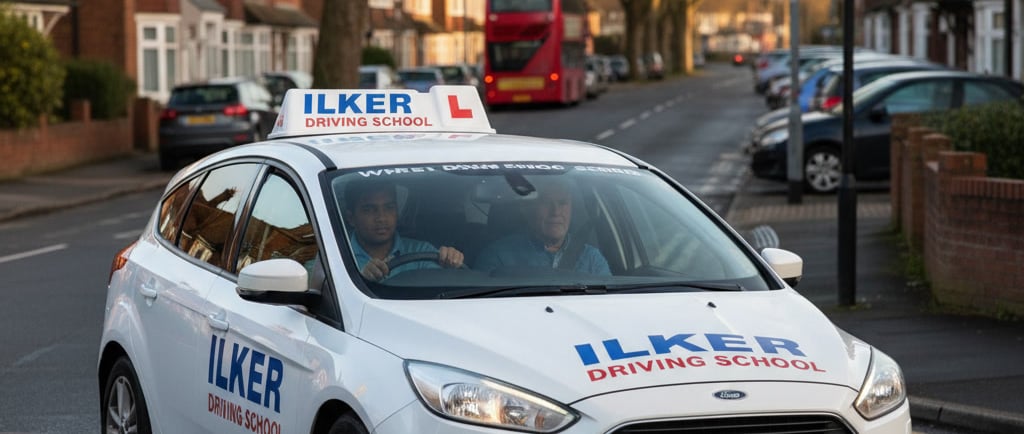How Many Driving Lessons Do You Need in Chingford & Loughton?
This post pulls together the kind of advice you’ll find from local instructors, UK driving schools, and DVSA guidance, and then relates it to real conditions in Chingford and Loughton.
11/16/20255 min read


How Many Driving Lessons Do You Need in Chingford & Loughton?
If you’re learning to drive around Chingford or Loughton, you’ve probably seen lots of different answers online:
“You can pass in 10–15 lessons.”
“Most people need 30 hours.”
“Plan for 40–50 hours.”
So which is true?
This post pulls together the kind of advice you’ll find from local instructors, UK driving schools, and DVSA guidance, and then relates it to real conditions in Chingford and Loughton.
The short answer
Putting together typical advice from UK driving schools and local instructors, the realistic answer for this area is:
Most first‑time learners:
Around 35–50 hours of professional lessons, plus private practice if possible.Learners who’ve already failed once:
Often need 5–10 extra hours of focused tuition to fix weaknesses and rebuild confidence.
That’s not a fixed rule, but it’s the range you’ll see again and again from reputable UK instructors – and it fits what many ADIs around Chingford/Loughton report.
What official guidance says (DVSA)
The DVSA (the body that sets the driving test) often quotes an average figure:
Around 45 hours of professional driving lessons, plus about 22 hours of private practice.
Many UK driving school websites and instructors repeat something similar, often rounding it to:
“About 40–50 hours with an instructor for a typical learner.”
In real life, some people need less, some more – but this is the baseline most professionals work from.
Why Chingford & Loughton learners often sit in the higher range
Compared to very quiet rural areas, Chingford and Loughton present some extra challenges:
Chingford test centre is known for:
Tight residential roads with lots of parked cars
Mini‑roundabouts and awkward junctions
One‑way systems where observation and road markings really matter
Nearby major roads like the A406 require:
Confident joining and leaving at speed
Lane discipline
Good judgement in busy, fast‑moving traffic
School runs and rush hours bring:
Heavy traffic
Pedestrians crossing unpredictably
Buses and impatient drivers
This environment means learners don’t just need to control the car – they need strong observation, anticipation and decision‑making. That usually pushes most learners towards the upper end of that 35–50 hour range.
Factors that change how many lessons you need
1. Previous experience
If you’ve never driven at all, not even on private land, you’ll probably be closer to the average or higher end of the range.
If you’ve done some driving before (other country, private land, off‑road practice), you might need fewer hours – but you may also need time to unlearn bad habits.
2. How often you have lessons
Across UK driving schools, this pattern is common:
2 hours per week (one 2‑hour lesson) – a very solid pace. You remember more between lessons and progress steadily.
1 hour per week – slower progress, more time spent recapping.
Irregular lessons – lots of gaps = lots of forgetting = more total hours.
Many instructors in and around Chingford/Loughton prefer 2‑hour sessions, because you can do a proper mix of residential roads, busier roads and a bit of A406 or similar, all in one go.
3. Private practice
DVSA and most UK instructors say:
Learners who can do regular private practice with parents/guardians often need fewer paid hours.
The DVSA “average” of 45 hours of lessons is usually quoted with about 22 hours of private practice on top.
But it has to be good practice:
If you practise safe routines (mirrors, signals, positioning, speed control) and follow what your instructor teaches, it accelerates your progress.
If you practise bad habits (speeding, poor observation, sloppy steering), your instructor will have to spend extra time correcting them later.
In Chingford/Loughton specifically, private practice on familiar local routes (school runs, shopping trips, evenings around estates) can really help if it’s supervised properly and aligned with what your instructor wants.
4. Confidence and nerves
Local instructors regularly mention that nervous or anxious learners:
Tend to need more lessons, especially before they feel ready for complex junctions and A406‑type dual carriageways.
May drive the car physically well, but struggle with decision‑making under pressure.
If you’re naturally calm and used to busy environments, you might be towards the lower end of the hour range. If you’re anxious, give yourself permission to take longer – that doesn’t mean you’re a bad driver.
What “ready for test” looks like here
Instead of obsessing over lesson numbers, most good instructors in the area use a skill checklist. You’re likely to be test‑ready when you can:
Drive 35–40 minutes around Chingford/Loughton with only minimal input from your instructor.
Deal with tight residential roads and meeting oncoming traffic around parked cars.
Handle mini‑roundabouts and one‑way systems without hesitation or confusion.
Join, leave and drive on faster roads (like the A406) safely, with good lane discipline.
Do all the manoeuvres (bay park, parallel park, pulling up on the right, etc.) smoothly and under a bit of pressure.
Cope with busy times (school runs, rush hour, buses) without panicking.
Follow sat‑nav or verbal directions while still prioritising mirrors, signs and hazards.
If you can’t yet do these things reliably, most instructors would say you probably need more lessons, even if you’ve already done a lot of hours.
Typical lesson numbers you’ll see quoted
Looking across UK driving schools and local‑style guidance, you’ll find something like:
Quick, confident learners with good private practice
Maybe 25–35 hours of professional lessons
Plus regular practice with parents
Average first‑time learners in busy areas like Chingford/Loughton
Often 35–50 hours of lessons
With or without some extra private practice
Nervous learners, or those who take long breaks between lessons
Sometimes 50+ hours to become truly safe and confident
Learners who’ve already failed a test
If their driving is still fairly fresh: 5–10 extra hours focused on weak areas
If they leave a long gap before trying again, they may need more.
These aren’t promises – just realistic ranges based on what many UK instructors report.
Problems with trying to do “the minimum”
A lot of blogs and local sites warn about the same mistake:
Trying to “race” to a licence in as few lessons as possible.
The problems:
You might end up failing multiple tests, which costs:
More test fees
Extra last‑minute lessons
A lot of stress and damage to confidence
You could pass the test but then:
Avoid certain roads (like the A406 or busy junctions) because they scare you
Be unsafe in situations you don’t know yet
Most experienced instructors prefer to see students take a few extra hours and be genuinely safe, rather than rush to the test just because they’ve hit some arbitrary number like “20 lessons”.
How to work out how many lessons you need
Instead of asking, “How many lessons should I need?”, try this:
Ask your instructor directly:
“Based on how I’m driving now, roughly how many more hours do you think I’ll need to be test‑ready?”
“What specific things are holding me back at the moment?”
Ask for a mock test:
A full 35–40 minute mock on typical Chingford routes will reveal a lot.
If your instructor has to give constant help, you’re not ready yet.
Be honest with yourself:
Around local roads, can you drive independently without feeling like you’re guessing or clinging to luck?
If you want a rough planning number for Chingford & Loughton:
Budget for around 35–50 hours of professional lessons.
If you’ve already failed once, expect 5–10 focused hours to correct mistakes and rebuild confidence.
Add private practice where possible, but make sure it follows your instructor’s guidance.
Final thoughts
There’s no single magic number of lessons that suits everyone. But if you’re learning in Chingford or Loughton, you’re dealing with:
Busy London‑area roads
Tight residential streets
One‑way systems and mini‑roundabouts
Faster roads like the A406
That’s why most serious, experienced instructors – and the DVSA averages – point towards something like 40–50 hours for a typical learner to become safe, confident and genuinely ready.
Use that as a realistic starting point, then adjust based on:
Your confidence
Your progress
Your instructor’s feedback
How well you handle the real roads you’ll be driving on every day.
